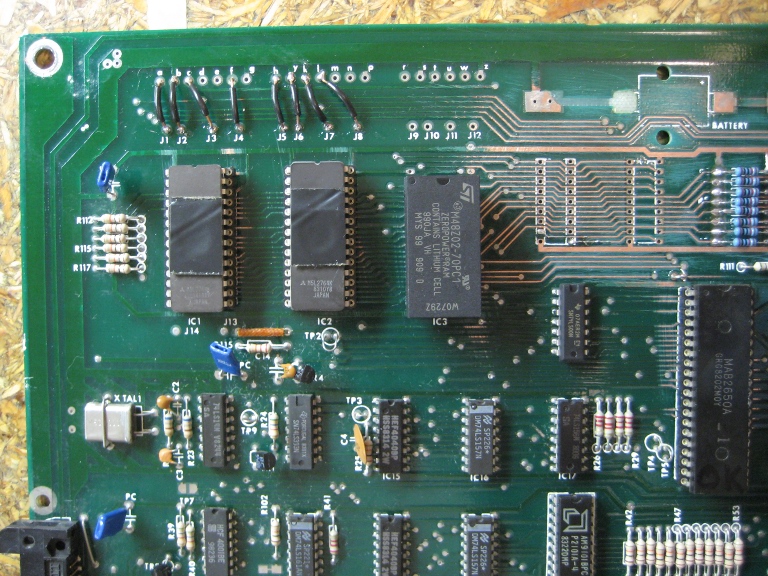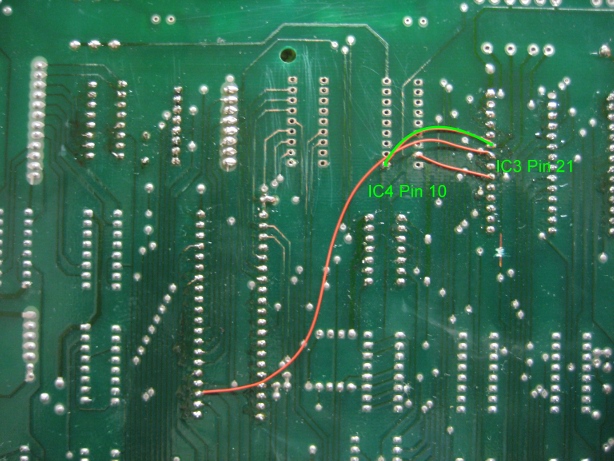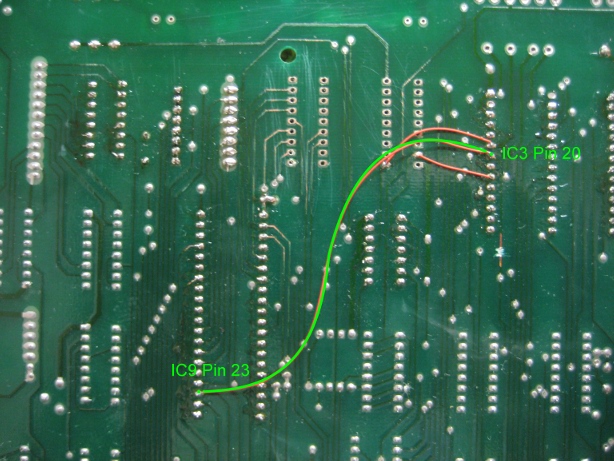
The biggest worry with a Zaccaria CPU board is the NiCd battery pack used to maintain the CMOS memory when the game is powered off. This battery pack is mounted at the top of the circuit board, in the center. When it starts to leak, the battery fluid runs down the board and ruins the components in its path. I repair at least a dozen battery damaged CPU boards every year because of this design.
A few years ago, another collector told me that he had modified a 1B1165 CPU board to use ST Microdevice's "ZeroPower" RAM, in place of the usual 6514 and 2114 in IC4 and IC5. I thought this was an interesting idea, so I purchased a couple of these devices to test them, then got sidetracked and never got around to actually doing it.
6514 and 2114 RAM chips are still readily available, but with the demise of through-hole board development and the parts needed to build and repair them, I can forsee a day when 6514 and 2114 chips will no longer be available. The "ZeroPower" RAM, being a relatively new design, I hope will be available far in to the future.
The "ZeroPower" RAM device combines 2Kx8 SRAM, a Lithium battery, and power failure detection circuitry, all in a single 24-pin package. It is designed to be compatible with common EPROM pin layouts, and with common RAM uses. When power is applied, the device runs from the system +5V and Gnd. When power is removed, the device detects this and automatically switches to battery power to maintain memory. According to the datasheet, the device battery is good for at least ten years of backup power.
For this project, I am using the M48Z02-70PC1. The datasheet for it is here.
This device can be ordered from Mouser Electronics. Currently it is Mouser part number 511-M48Z0270-PC1.
Looking at the pin layout of this device, it is remarkably similar to a 2732 EPROM. The address lines (A0-A10) are all in the same locations; the data lines (D0-D7) are also identical. +5V (Vcc) and Gnd (Vss) are the same. The only differences are the E, G, and W lines. Better yet, Zaccaria have three ROM socket positions on the 1B1165 board, but on almost all of their games, only two of them are used. The other is perfectly situated for use as a location for the "ZeroPower" RAM.
First, assuming that the board has some existing battery damage, it will need to be cleaned up, neutralized, and any damaged components replaced. You can see in the pictures, the board I am modifying here had some moderate corrosion around IC4 and IC5 and around R2-R9. None of it was bad enough to eat through the traces, though, which was fortunate.
 |
1. Remove R1, D1, and D2.
These components provide the battery charging circuit. Since there will be no battery, there is no need for them.
2. Remove IC4 and IC5.
This may be obvious, but the existing RAM chips have to be removed. Since that is usually needed for repairing a battery damaged board, this step might also be just "do not install new IC4 or IC5".
3. Remove jumpers J9, J10, J11, J12.
If these jumpers for ROM3 are even present, which they likely are not, remove them.
4. Install socket at IC3.
I used machine pin SIP socket strips for this step. An open frame machine pin socket might be a better choice. Some 1B1165 boards may already have a socket here, especially if they came from a Soccer Kings, Pinball Champ, or Time Machine originally. By Farfalla, and for the games after it, only two sockets at IC1 and IC2 are normally installed.
While there seems to be sufficient tension on the device legs to keep it in its socket, it might be even better to use an open frame socket so that a zip tie could be wrapped around the device, under the socket, making it even less likely that the device could be jostled loose in transport.
5. Cut CHIP SELECT at IC3.
Because we are installing RAM in the socket that was intended for ROM3, the CHIP SELECT line for ROM3 must be cut. CHIP SELECT goes, via jumper J13, over to ROM2 in games that use only two ROMs.
 |
6. Connect CHIP SELECT to E.
Install a jumper wire from IC4 pin 8 to IC3 pin 18. This connects the CHIP SELECT (RAM) signal to the CHIP ENABLE (E) line of the ZeroPower RAM device.
 |
7. Connect READ/WRITE to W.
Install a jumper wire from IC4 pin 10 to IC3 pin 21. This connects the READ/WRITE (RAM) signal to the WRITE (W) line of the ZeroPower RAM device.
 |
8. Connect READ/WRITE to G.
Install a jumper wire from IC9 pin 23 to IC3 pin 20. This connects the READ/WRITE (CPU) signal to the OUTPUT ENABLE (G) line of the ZeroPower RAM device.
 |
9. 1B1165/2
If the board being modified is a 1B1165/2, then jumper J16 must be changed to the "F" postion. This jumper connects IC8 to battery (Vbatt) power. Since there will be no battery, returning J16 to the "F" setting powers IC8 from the usual +5V (Vcc) source.
The Results
 |
 |
| Modified 1B1165 - Front | Modified 1B1154 - Back |
Having completed these modifications, I jumpered this board for 2 x 2764 ROMs in IC1 and IC2, then installed my Test ROM images in IC1 and IC2. After proving that all subsystems of the board worked correctly with the ZeroPower RAM installed, I then installed FARFALLA ROMs in it, and have been running it in my game as a test. So far, I have no problems to report and it is working fine.
At $12/chip, this is not an inexpensive device, but as I am currently paying about $5/chip for 6514 and 2114 RAM, and $4/each for 5V 1F memory backup capacitors, it is actually slightly less expensive when repairing a battery damaged board. And depending on the repairs needed, may actually be a better way to repair a board with significant corrosion damage to the traces around IC4 and IC5. The only part of this that I do not like is the modifications needed to make it work. But, with the wire modifications on the back side of the board, they are not immediately obvious or especially ugly and are reasonably well protected from damage.
David Gersic info@zaccaria-pinball.com
Copyright © 2010. All rights reserved.
This document may be freely distributed so long as the content is not modified.